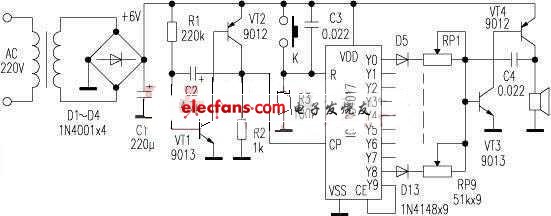The self-made music arrangement doorbell circuit is shown in the figure below. The 220V AC power is stepped down by the transformer, D1~D4 rectification, C1 filtering, and the +6V DC voltage is obtained. The IC is a decimal counter divider CD4017, Y0~Y9 are ten count output terminals, and R is a high level reset terminal. After the power is turned on, the CD4017 completes the power-on reset because the voltage at the C3 terminal cannot be abruptly changed. Only the Y0 terminal outputs a high level, and the remaining output terminals are all at a low level. CP is the count pulse input of CD4017, which is triggered by the rising edge of the pulse. Transistors VT3, VT4 and C4 and RP1 ~ RP9 constitute a note oscillator, the operating frequency of the oscillator is controlled by the high and low levels of the output of the CD4017 count output terminals Y0 ~ Y8. VT1, VT2 and surrounding components form a count pulse generator circuit that sends a count trigger pulse to the CD4017. The CE end of CD4017 is the enable end of the counting input. When CE is connected to the low level, the CP end of CD4017 accepts the trigger of the rising edge of the pulse to count; when CE is connected to the high level, the CP end will be locked, and the trigger of the pulse is not accepted. At this time, the state of the CD4017 output will remain unchanged at the previous moment. The working principle of the circuit is: CD4017 is reset after power-on, Y0 outputs high level, Y1~Y9 outputs low level, and Y9's low level is connected to CE end, so that CP end can accept the trigger of counting pulse. The high level of Y0 output makes diode D5 turn on, and RP1 is connected to the note oscillator circuit. The operating frequency of the oscillator is determined by RP1 and C4. Adjusting RP1 will make the speaker emit the first note.
This article refers to the address: http://
At the same time, the oscillator consisting of VT1, VT2 and R1, R2, and C2 starts to send a count pulse to the CP terminal, and the CD4017 starts counting. The first counting pulse makes Y1 output high level (other output terminals are low level), diode D5 is turned off, D6 is turned on, RP2 is connected to the note oscillator circuit, and the operating frequency of the oscillator is determined by RP2 and C4. Adjusting the RP2 causes the speaker to emit a second note. Similarly, the second counting pulse makes Y2 output high level, diode D6 is turned off, D7 is turned on, RP3 will be connected to the note oscillator circuit, the operating frequency of the oscillator is determined by RP3 and C4, and the speaker can be adjusted by adjusting RP3. Issue the third speaker. And so on, then the fourth, fifth... until the diode D13 turns on, the note oscillator emits the ninth note. Finally, Y9 outputs a high level. This high level is connected to the CE terminal to lock the CP terminal of CD4017, and no longer accepts the trigger of the counting pulse. The output terminals Y0~Y9 will remain at the high level of Y9, while the output states of Y0~Y8 are low level, D5~D13 are all turned off, the note oscillator stops, and the speaker does not sound. K is the doorbell button. When a guest arrives, press K, the R terminal changes to a high level, the CD4017 resets at a moment, the Y0 terminal outputs a high level, and the remaining outputs all go low. At this time, the low level of the Y9 output is connected to the CE end, so that the CP end is unlocked, and the trigger of the counting pulse is resumed. Under the trigger of the counting pulse, the diodes D5 to D13 are turned on in turn, and RP1 to RP9 are sequentially connected to the note oscillator, and the speaker sequentially plays nine notes to complete a duty cycle. Increasing or decreasing the value of the capacitor C2 can change the period of the trigger pulse, so that the length of each note can be changed. Carefully adjust the values ​​of RP1 ~ RP9, so that the note oscillator emits nine different tones as we want, and nine tones are sent out to form a small piece of music. If you want to make one of the notes sound a little longer, for example, it is customary that the last note is longer. Just use the two outputs of Y7 and Y8 in parallel and isolate them with a diode between them.

Summary: This article introduces a music doorbell circuit that can be arranged by itself . It can issue 9 notes in sequence, which is suitable for the experiment of electronic enthusiasts who like to pursue individuality.
Dc Gear Motor,Geared Motor,Dc Gear Motor 12V,Low Speed Gear Motor
Changzhou Sherry International Trading Co., Ltd. , https://www.sherry-motor.com
